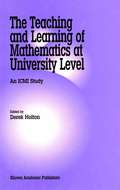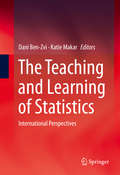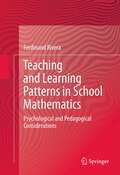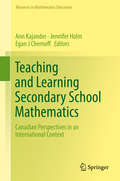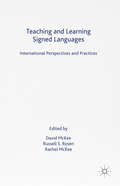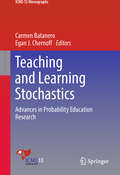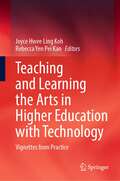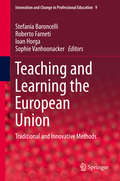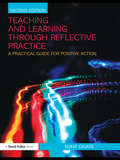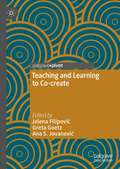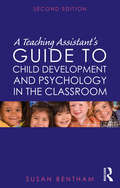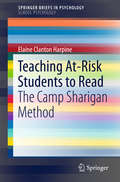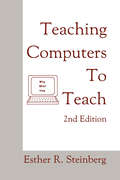- Table View
- List View
The Teaching and Learning of Mathematics at University Level: An ICMI Study (New ICMI Study Series #7)
by Derek HoltonThis is a text that contains the latest in thinking and the best in practice. It provides a state-of-the-art statement on tertiary teaching from a multi-perspective standpoint. No previous book has attempted to take such a wide view of the topic. The book will be of special interest to academic mathematicians, mathematics educators, and educational researchers. It arose from the ICMI Study into the teaching and learning of mathematics at university level (initiated at the conference in Singapore, 1998).
The Teaching and Learning of Statistics: International Perspectives
by Dani Ben-Zvi Katie MakarThis book presents the breadth and diversity of empirical and practical work done on statistics education around the world. A wide range of methods are used to respond to the research questions that form it's base. Case studies of single students or teachers aimed at understanding reasoning processes, large-scale experimental studies attempting to generalize trends in the teaching and learning of statistics are both employed. Various epistemological stances are described and utilized.The teaching and learning of statistics is presented in multiple contexts in the book. These include designed settings for young children, students in formal schooling, tertiary level students, vocational schools, and teacher professional development. A diversity is evident also in the choices of what to teach (curriculum), when to teach (learning trajectory), how to teach (pedagogy), how to demonstrate evidence of learning (assessment) and what challenges teachers and students face when they solve statistical problems (reasoning and thinking).
Teaching and Learning Patterns in School Mathematics: Psychological and Pedagogical Considerations
by Ferdinand RiveraThis book synthesizes research findings on patterns in the last twenty years or so in order to argue for a theory of graded representations in pattern generalization. While research results drawn from investigations conducted with different age-level groups have sufficiently demonstrated varying shifts in structural awareness and competence, which influence the eventual shape of an intended generalization, such shifts, however, are not necessarily permanent due to other pertinent factors such as the complexity of patterning tasks. The book proposes an alternative view of pattern generalization, that is, one that is not about shifts or transition phases but graded depending on individual experiences with target patterns. The theory of graded representations involving pattern generalization offers a much more robust understanding of differences in patterning competence since it is sensitive to varying levels of entry into generalization. Empirical evidence will be provided to demonstrate this alternative view, which is drawn from the author’s longitudinal work with elementary and middle school children, including several investigations conducted with preservice elementary majors. Two chapters of the book will be devoted to extending pattern generalization activity to arithmetic and algebraic learning of concepts and processes. The concluding chapter addresses the pedagogical significance of pattern learning in the school mathematics curriculum.
Teaching and Learning Secondary School Mathematics: Canadian Perspectives In An International Context (Advances in Mathematics Education)
by Ann Kajander Jennifer Holm Egan J ChernoffThis volume brings together recent research and commentary in secondary school mathematics from a breadth of contemporary Canadian and International researchers and educators. It is both representative of mathematics education generally, as well as unique to the particular geography and culture of Canada. The chapters address topics of broad applicability such as technology in learning mathematics, recent interest in social justice contexts in the learning of mathematics, as well as Indigenous education. The voices of classroom practitioners, the group ultimately responsible for implementing this new vision of mathematics teaching and learning, are not forgotten. Each section includes a chapter written by a classroom teacher, making this volume unique in its approach. We have much to learn from one another, and this volume takes the stance that the development of a united vision, supported by both research and professional dialog, provides the first step.
Teaching and Learning Signed Languages: International Perspectives and Practices
by Russell S. Rosen David McKee Rachel McKeeTeaching and Learning Signed Languages examines current practices, contexts, and the research nexus in the teaching and learning of signed languages, offering a contemporary, international survey of innovations in this field.
Teaching and Learning Stochastics: Advances in Probability Education Research (ICME-13 Monographs)
by Carmen Batanero Egan J ChernoffThis book presents a collection of selected papers that represent the current variety of research on the teaching and learning of probability. The respective chapters address a diverse range of theoretical, empirical and practical aspects underpinning the teaching and learning of probability, curricular issues, probabilistic reasoning, misconceptions and biases, as well as their pedagogical implications. These chapters are divided into THREE main sections, dealing with: TEACHING PROBABILITY, STUDENTS' REASONING AND LEARNING AND EDUCATION OF TEACHERS.In brief, the papers presented here include research dealing with teachers and students at different levels and ages (from primary school to university) and address epistemological and curricular analysis, as well as the role of technology, simulations, language and visualisation in teaching and learning probability. As such, it offers essential information for teachers, researchers and curricular designers alike.
Teaching and Learning the Arts in Higher Education with Technology: Vignettes from Practice
by Joyce Hwee Ling Koh Rebecca Yen Pei KanThis book is an inquiry about the possibilities of using technology to support the education of artists within higher education contexts. Even though technology-enhanced learning and teaching may seem incongruent with the long-established studio-based cultures of making and performing, it is increasingly becoming a pivotal point to connect artistes to potential audience and markets. Amidst the COVID-19 pandemic, technology is also the crucial linchpin for educational continuity of student artists. This book explores how technology could enhance the education of artists and designers as they continue to create, make, and add value to life and society through their artistry. It draws upon the experiences of the Nanyang Academy of Fine Arts (NAFA), a pioneering arts institution in Singapore with over 80 years of institutional history. Through 9 vignettes, this book illustrates technology-enhanced pedagogical practices that have been implemented in different artistic learning spaces including classroom, studio, and stage as well as institutional support strategies. With a naturalistic stance, these chapters seek to illuminate realistic pictures of teaching and learning that are being uncovered by artist educators as they sought to integrate technology within teaching practices using available technologies and within the classes that they are teaching. It is hoped that this book will stimulate conversation among artist educators about possible pedagogical models, as well as inform higher arts institutions about the contextual strategies needed to support the creation of technology-enhanced pedagogical practices.
Teaching and Learning the European Union: Traditional and Innovative Methods (Innovation and Change in Professional Education #9)
by Stefania Baroncelli Roberto Farneti Ioan Horga Sophie VanhoonackerThis volume examines the EU’s changing educational context and its challenges. Based on an extensive survey of more than 2000 European Studies courses in 30 European countries, it maps and analyses the features of teaching methodologies as they emerge from both disciplinary as well as interdisciplinary curricula. It presents a series of case studies on some of the most-used innovative teaching tools emerging in the field such as simulation games, e-learning, problem based learning, blended learning, and learning through the use of social networks. Based on the contributors’ own experiences and academic research, the book examines both strengths and possible pitfalls of these increasingly popular methods. The book’s critical approach will inspire educators and scholars committed to improving the teaching methods and tools in the area of European Studies and other programmes of higher education facing similar challenges.
Teaching and Learning through Reflective Practice: A Practical Guide for Positive Action
by Tony GhayeNow in its second edition, Teaching and Learning through Reflective Practice is a practical guide to enable all those involved in educational activities to learn through the practices of reflection. The book highlights the power that those responsible for teaching and learning have to appraise, understand and positively transform their teaching. Seeing the teacher as a reflective learner, the book emphasises a strengths-based approach in which positivity, resilience, optimism and high performance can help invigorate teaching, enhance learning and allow the teacher to reach their full potential. This approach busts the myth that reflection on problems and deficits is the only way to better performance. The approach of this new edition is an ‘appreciative’ one. At its heart is the exploration and illustration of four reflective questions: What’s working well? What needs changing? What are we learning? Where do we go from here? With examples drawn from UK primary teacher education, the book reveals how appreciative reflective conversations can be initiated and sustained. It also sets out a range of practical processes for amplifying success. This book will be a must have for undergraduate and PGCE students on initial teacher training programmes. It will also interest practising teachers, teacher educators and those on continuing professional development courses.
Teaching and Learning through Reflective Practice: A Practical Guide for Positive Action
by Tony GhayeNow in its second edition, Teaching and Learning through Reflective Practice is a practical guide to enable all those involved in educational activities to learn through the practices of reflection. The book highlights the power that those responsible for teaching and learning have to appraise, understand and positively transform their teaching. Seeing the teacher as a reflective learner, the book emphasises a strengths-based approach in which positivity, resilience, optimism and high performance can help invigorate teaching, enhance learning and allow the teacher to reach their full potential. This approach busts the myth that reflection on problems and deficits is the only way to better performance. The approach of this new edition is an ‘appreciative’ one. At its heart is the exploration and illustration of four reflective questions: What’s working well? What needs changing? What are we learning? Where do we go from here? With examples drawn from UK primary teacher education, the book reveals how appreciative reflective conversations can be initiated and sustained. It also sets out a range of practical processes for amplifying success. This book will be a must have for undergraduate and PGCE students on initial teacher training programmes. It will also interest practising teachers, teacher educators and those on continuing professional development courses.
Teaching and Learning to Co-create
by Jelena Filipović Greta Goetz Ana S. JovanovićThis edited book approaches the learning experience as a creative, constructive process from an epistemological orientation that combines transdisciplinary, participatory, and collaborative approaches to explore the most constructive ways forward for a networked constructivist (project- and problem-based) pedagogy. The volume emphasizes the value of a number of modes of inquiry that, among others, include ethnography, auto-ethnography, corpus analysis, narrative analysis, and their many intersections in the process of academic maturation and growth. This book will be of interest to applied linguists, sociolinguists, researchers, and educators of topics related to higher education and academic maturation, networked learning, qualitative inquiry and transdisciplinary studies.
Teaching and Measuring Cognitive Readiness
by Harold F. O'Neil Ray S. Perez Eva L. BakerTeaching and Measuring Cognitive Readiness presents theoretical and empirical findings regarding cognitive readiness and assessments of their impact on adult learning. The term readiness is used in assessing student preparation for K-12 schools, while in the military and in industry, "readiness" denotes preparation to be effective in performing a mission or a job. Cognitive Readiness is viewed through a Knowledge, Skills, and Attributes (KSA) lens.Teaching and Measuring Cognitive Readiness deals with (a) the primacy of cognitive readiness as attributes or individual difference variables; (b) the need for cognitive readiness instructional and assessment strategies; (c) the need to integrate assessment into cognitive readiness training; (d) the need for theory-driven evaluation studies to increase knowledge and efficacy in teaching cognitive readiness; and (e) the need for a solid psychometric approach to the use of cognitive readiness assessments.
Teaching and Researching: Motivation (PDF)
by Zoltán Dörnyei Ema UshiodaCultivating motivation is crucial to a language learner's success - and therefore crucial for the language teacher and researcher to understand. This fully revised edition of a groundbreaking work reflects the dramatic changes the field of motivation research has undergone in recent years, including the impact of language globalisation and various dynamic and relational research methodologies, and offers ways in which this research can be put to practical use in the classroom and in research. Key new features and material: A brand new chapter on current socio-dynamic and complex systems perspectives New approaches to motivating students based on the L2 Motivational Self System Illustrative summaries of qualitative and mixed methods studies Samples of new self-related motivation measures Providing a clear and comprehensive theory-driven account of motivation, Teaching and Researching Motivation examines how theoretical insights can be used in everyday teaching practice, and offers practical tips. The final section provides a range of useful resources, including relevant websites, key reference works and tried and tested example questionnaires. Written in an accessible style and illustrated with concrete examples, itis an invaluable resource for teachers and researchers alike. 9781408205129
Teaching and Researching: Motivation
by Zoltán Dörnyei Ema UshiodaCultivating motivation is crucial to a language learner's success - and therefore crucial for the language teacher and researcher to understand. This fully revised edition of a groundbreaking work reflects the dramatic changes the field of motivation research has undergone in recent years, including the impact of language globalisation and various dynamic and relational research methodologies, and offers ways in which this research can be put to practical use in the classroom and in research. Key new features and material: A brand new chapter on current socio-dynamic and complex systems perspectives New approaches to motivating students based on the L2 Motivational Self System Illustrative summaries of qualitative and mixed methods studies Samples of new self-related motivation measures Providing a clear and comprehensive theory-driven account of motivation, Teaching and Researching Motivation examines how theoretical insights can be used in everyday teaching practice, and offers practical tips. The final section provides a range of useful resources, including relevant websites, key reference works and tried and tested example questionnaires. Written in an accessible style and illustrated with concrete examples, itis an invaluable resource for teachers and researchers alike. 9781408205129
Teaching and Supervising Cognitive Behavioral Therapy
by Donna M. Sudak R. Trent Codd III John W. Ludgate Leslie Sokol Marci G. Fox Robert P. Reiser Derek L. MilneA total CBT training solution, with practical strategies for improving educational outcomes. Teaching and Supervising Cognitive Behavioral Therapy is the first comprehensive package to provide empirically-validated CBT training and supervisory techniques. Applicable to a variety of behavioral health care disciplines, this multi-modal guide provides educators with the information and tools that can help improve educational outcomes. An examination of CBT developments over the past twenty years leads into a discussion of practical applications for improving CBT education, while addressing the technological advances that facilitate dissemination and the specific challenges posed to confidentiality and patient care. The digital component contains additional audio and video content, plus downloadable worksheets that reinforce and expand upon the strategies presented. Coverage includes advice geared specifically toward the most commonly-encountered problems, with video of training sessions that address issues like frustration with patients, disbelief in psychotherapy, dislike of the method, and lack of skills. Readers will gain insight into effective goal setting, and implement a structured approach to supervision. Examine existing literature and research on training, supervision, and evaluation Integrate theory with practical strategies to improve learning outcomes Customize training approaches to specifically suit different professional groups Fit the methods to the environment, including workshops, webinars, and podcasts Mental health professionals who favor an empirically-based approach to therapy will appreciate the effectiveness of an empirically-based approach to pedagogy. Backed by over two decades of CBT research and the insight of leading CBT experts, Teaching and Supervising Cognitive Behavioral Therapy provides trainers with the tools and information they need to improve therapist educational outcomes.
Teaching and Supervising Cognitive Behavioral Therapy
by Donna M. Sudak R. Trent Codd III John W. Ludgate Leslie Sokol Marci G. Fox Robert P. Reiser Derek L. MilneA total CBT training solution, with practical strategies for improving educational outcomes. Teaching and Supervising Cognitive Behavioral Therapy is the first comprehensive package to provide empirically-validated CBT training and supervisory techniques. Applicable to a variety of behavioral health care disciplines, this multi-modal guide provides educators with the information and tools that can help improve educational outcomes. An examination of CBT developments over the past twenty years leads into a discussion of practical applications for improving CBT education, while addressing the technological advances that facilitate dissemination and the specific challenges posed to confidentiality and patient care. The digital component contains additional audio and video content, plus downloadable worksheets that reinforce and expand upon the strategies presented. Coverage includes advice geared specifically toward the most commonly-encountered problems, with video of training sessions that address issues like frustration with patients, disbelief in psychotherapy, dislike of the method, and lack of skills. Readers will gain insight into effective goal setting, and implement a structured approach to supervision. Examine existing literature and research on training, supervision, and evaluation Integrate theory with practical strategies to improve learning outcomes Customize training approaches to specifically suit different professional groups Fit the methods to the environment, including workshops, webinars, and podcasts Mental health professionals who favor an empirically-based approach to therapy will appreciate the effectiveness of an empirically-based approach to pedagogy. Backed by over two decades of CBT research and the insight of leading CBT experts, Teaching and Supervising Cognitive Behavioral Therapy provides trainers with the tools and information they need to improve therapist educational outcomes.
A Teaching Assistant's Guide to Child Development and Psychology in the Classroom: Second edition
by Susan BenthamHow can you help students most effectively in the classroom? As a Teaching Assistant, you play a vital role in today’s schools. This fully updated new edition will help you get to grips with the main issues to do with psychology and its role in the processes of teaching and learning. This accessible text, building on the success of a best-selling previous edition, provides informative, yet down-to-earth commentary with clear examples of how you can apply this knowledge in everyday practice. The book addresses issues including: how to support learning how to identify and cater for different learning styles teaching children with additional needs how to manage behaviour to support learning how to help children with their self-esteem and independence. This new edition includes references to up-to-date research in child development and psychology to include information regarding personalised learning, creativity, motivation, friendships skills, moral development and neuroscience. Chapters are complemented with lively case studies, self-assessment questions and examples of how to apply theory to everyday classroom practice. The reader is encouraged to develop reflective practice to best support childrens’ behaviour and learning. This reader-friendly book is an invaluable companion for every Teaching assistant, HLTA, Cover Supervisor, and anyone working in a supporting role in an educational setting.
A Teaching Assistant's Guide to Child Development and Psychology in the Classroom: Second edition
by Susan BenthamHow can you help students most effectively in the classroom? As a Teaching Assistant, you play a vital role in today’s schools. This fully updated new edition will help you get to grips with the main issues to do with psychology and its role in the processes of teaching and learning. This accessible text, building on the success of a best-selling previous edition, provides informative, yet down-to-earth commentary with clear examples of how you can apply this knowledge in everyday practice. The book addresses issues including: how to support learning how to identify and cater for different learning styles teaching children with additional needs how to manage behaviour to support learning how to help children with their self-esteem and independence. This new edition includes references to up-to-date research in child development and psychology to include information regarding personalised learning, creativity, motivation, friendships skills, moral development and neuroscience. Chapters are complemented with lively case studies, self-assessment questions and examples of how to apply theory to everyday classroom practice. The reader is encouraged to develop reflective practice to best support childrens’ behaviour and learning. This reader-friendly book is an invaluable companion for every Teaching assistant, HLTA, Cover Supervisor, and anyone working in a supporting role in an educational setting.
Teaching At-Risk Students to Read: The Camp Sharigan Method (SpringerBriefs in Psychology)
by Elaine Clanton HarpineThis Brief provides the theoretical foundation of the Camp Sharigan program, while discussing its practical applications and summarizing research studies. It addresses the question often raised in literature and in school-based settings: What is the most effective way to teach children to read? Chapters explore a group-centered approach to correcting reading failure and offers research-based field studies to demonstrate the success of the Camp Sharigan method. The group-centered theory combines learning and counseling into the same program to strengthen education and mental health. In addition, creative-art therapy techniques are also explained and demonstrated. Featured topics in this Brief include: Vowel clustering and its use in improving phonemic awareness. Why group-centered prevention is better for teaching. The importance of cohesion and cohesive-learning in group-centered prevention. The use of individualized rotation to increase motivation and instruction in children who struggle to read. Teaching At-Risk Students to Read is as an essential resource for psychology and educational professionals as well as researchers and graduate students who are interested in improving teaching methods with at-risk students, reducing school dropout rates, increasing intrinsic motivation for struggling readers, changing to an effective method for teaching children to read, improving student engagement, and strengthening self-regulated learning.
Teaching Clients to Use Mindfulness Skills: A practical guide
by Christine Dunkley Maggie StantonMindfulness has become a vital skill for many people working in the fields of physical and mental health, teaching, business, leadership and sports. While plenty of books explain the uses of mindfulness, until now none has addressed the particular challenges of effectively passing these skills on to clients in a user-friendly way.Designed to help professionals introduce mindfulness to clients, the skills laid out here can help those struggling with problems of recurrent stress or ruminative thought, and benefit people wanting to live in a more effective, rewarding way. Incorporating a series of practical exercises and drawing on their own professional experience, the authors clearly demonstrate the most effective methods for presenting mindfulness techniques to those with no previous experience. Topics covered include: Orienting the client to the skill Obtaining and using client feedback effectively Introducing simple practises Teaching clients to utilise mindfulness in everyday life Case scenarios demonstrating the skills in practice This practical, structured guide is essential for professionals already teaching or planning to teach mindfulness skills, those taking courses or workshops and for anyone interested in learning more about mindfulness.
Teaching Clients to Use Mindfulness Skills: A practical guide
by Christine Dunkley Maggie StantonMindfulness has become a vital skill for many people working in the fields of physical and mental health, teaching, business, leadership and sports. While plenty of books explain the uses of mindfulness, until now none has addressed the particular challenges of effectively passing these skills on to clients in a user-friendly way.Designed to help professionals introduce mindfulness to clients, the skills laid out here can help those struggling with problems of recurrent stress or ruminative thought, and benefit people wanting to live in a more effective, rewarding way. Incorporating a series of practical exercises and drawing on their own professional experience, the authors clearly demonstrate the most effective methods for presenting mindfulness techniques to those with no previous experience. Topics covered include: Orienting the client to the skill Obtaining and using client feedback effectively Introducing simple practises Teaching clients to utilise mindfulness in everyday life Case scenarios demonstrating the skills in practice This practical, structured guide is essential for professionals already teaching or planning to teach mindfulness skills, those taking courses or workshops and for anyone interested in learning more about mindfulness.
Teaching Clients to Use Mindfulness Skills: A Practical Guide
by Christine Dunkley Maggie StantonThis book instructs readers on how to teach mindfulness skills that can be incorporated into everyday life, addressing the specific challenges of effectively passing these skills on to clients in a user-friendly way.Designed to help professionals introduce mindfulness to clients, the skills laid out in this book can help those struggling with problems of recurrent stress or ruminative thought, and benefit people wanting to live in a more effective, rewarding way. Incorporating a series of practical exercises and drawing on their own professional experience, the authors clearly demonstrate the most effective methods for presenting mindfulness techniques to those with no previous experience. Topics covered include orienting the client to the skill, obtaining and using client feedback effectively, and introducing simple practice. This newly updated edition features up-to-date references and new clinical examples and a new chapter focused on adapting the material for specific clinical populations and for working online.This practical, structured guide is essential for professionals already teaching or planning to teach mindfulness skills, those taking courses or workshops, and anyone interested in learning more about mindfulness.
Teaching Clients to Use Mindfulness Skills: A Practical Guide
by Christine Dunkley Maggie StantonThis book instructs readers on how to teach mindfulness skills that can be incorporated into everyday life, addressing the specific challenges of effectively passing these skills on to clients in a user-friendly way.Designed to help professionals introduce mindfulness to clients, the skills laid out in this book can help those struggling with problems of recurrent stress or ruminative thought, and benefit people wanting to live in a more effective, rewarding way. Incorporating a series of practical exercises and drawing on their own professional experience, the authors clearly demonstrate the most effective methods for presenting mindfulness techniques to those with no previous experience. Topics covered include orienting the client to the skill, obtaining and using client feedback effectively, and introducing simple practice. This newly updated edition features up-to-date references and new clinical examples and a new chapter focused on adapting the material for specific clinical populations and for working online.This practical, structured guide is essential for professionals already teaching or planning to teach mindfulness skills, those taking courses or workshops, and anyone interested in learning more about mindfulness.
Teaching Compassion: Humane Education In Early Childhood (Educating the Young Child #8)
by Mary Renck JalongoIn response to highly publicized incidents of school violence, educators across the United States and in many other nations are seeking effective ways to prevent and modify aggressive and anti-social behaviors in students. One of the major recommendations of the research is that efforts to prevent cruelty need to begin early, during the early childhood years of birth through age eight. The focus of Teaching Compassion: Humane Education in Early Childhood is guiding young children to accept responsibility for and to be kind in their interactions with fellow human beings, animals and the environment. Although humane education is a relatively new concept in the field of early childhood education, professionals in the field are very familiar with many of the related concepts, including: promoting positive interpersonal interactions, teaching children the skills of self-regulation, giving children experience in caring for living things and protecting the environment. This edited volume is an interdisciplinary compendium of professional wisdom gathered from experts in the fields of education, child development, science, psychology, sociology and humane organizations. As the book amply documents, the concept of humane education is powerful, integrative, timely and appropriate in work with young children.Teaching Compassion: Humane Education in Early Childhood shows how it is possible for adults dedicated to the care and education of young children to balance attention to the cognitive and affective realms and, in so doing, to elevate the overall quality of early childhood programs for children, families and communities.
Teaching Computers To Teach
by Esther R. SteinbergLike the original version of Teaching Computers to Teach, this updated edition presents procedures and principles for designing computer-presented instruction. It was written as a result of recent developments in three domains that have significant implications for computer-assisted instruction (CAI) and computer-based training (CBT). These areas are audio and videodisc technology, CAI and CBT experience, and research in the processes of learning. This practical book is written specifically for people who want to learn to design CAI. The book presents a CAI-specific design procedure by integrating knowledge about unique aspects of human-machine interaction with theories of learning and instruction as well as practical experience with CAI. The reader is guided through the entire design process, from initial planning to final evaluation, by clearcut principles and concrete examples.
